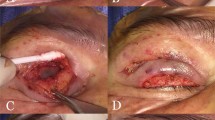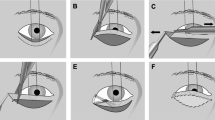Abstract
Background/Objectives
To determine whether the success and complication rates of the Lateral Tarsal Strip (LTS) Procedure, when treating involutional ectropion/entropion, is influenced by the use of suture when attaching the tarsal strip to the periosteum.
Subjects/Methods
Multi-centre retrospective comparative study of re-operation and complication rates (Recurrence, Dehiscence, Suture Infection, Granuloma, Haemorrhage, Residual-Lid Laxity, Suture Extrusion and Repeat Procedure) in LTS, between 01/01/2017 and 01/01/2022 who met the inclusion/exclusion criteria, for involutional ectropion/entropion using an absorbable polyglactin (vicryl) and non-absorbable polypropylene suture (prolene).
Results
1079 operations in 891 patients (36% female, average age 81.4 years) were performed with an average follow-up of 1.785 years. 588 operations in 475 patients were performed using prolene whilst 491 procedures in 416 patients were performed using vicryl sutures. Of these, 61% were performed by a consultant surgeon in the prolene group compared to 49.7% in the vicryl group. Overall complication rates between prolene and vicryl were 24.7% and 29.7% (p = 0.061) respectively. Higher complication rates for post-operative residual lid laxity, granuloma and suture infection were greater in the vicryl group versus prolene (2.65% and 0.51% p = 0.004, 2.24% and 0.68% p = 0.03, 1.83% and 0.17% p = 0.007 respectively). Non-significant results for dehiscence or repeat procedures (2.24% and 2.21% p = 0.974, 6.72% and 9.01% p = 0.166 respectively).
Conclusions
Both sutures are effective for the correction of involutional ectropion/entropion with LTS. Dehiscence and redo rates were not statistically significant. Nevertheless, the use of vicryl suture was found to be associated with a higher complication rate for: post-operative residual lid laxity, granuloma and suture infection.
This is a preview of subscription content, access via your institution
Access options
Subscribe to this journal
Receive 18 print issues and online access
$259.00 per year
only $14.39 per issue
Buy this article
- Purchase on Springer Link
- Instant access to full article PDF
Prices may be subject to local taxes which are calculated during checkout

Similar content being viewed by others
Data availability
Data available, on reasonable request, by contacting the corresponding author.
References
Mcveigh KA, Harrison R, Ford R. Entropion and ectropion repair: a snapshot of surgical practice in the United Kingdom. Orbit. 2018;37:105–9.
Vallabhanath P, Carter S. Ectropion and entropion. Curr Opin Ophthalmol. 2000;11:345–1.
Altieri M. The advantages of lateral tarsal strip procedure. J Surg Tech Case Rep. 2010;2:63.
Hsuan J, Selva D. The use of a polyglactin suture in the lateral tarsal strip procedure. Am J Ophthalmol. 2004;138:588–91.
Weber PJ, Popp JC, Wulc AE. Refinements of the Tarsal Strip Procedure. Ophthalmic Surg Lasers Imaging Retina. 1991;22:687–91.
Liu D. Lower eyelid tightening: a comparative study. Ophthalmic Plast Reconstr Surg. 1997;13:199–203.
Vahdani K, Ford R, Garrott H, Thaller VT. Lateral tarsal strip versus Bick’s procedure in correction of eyelid malposition. Eye. 2018;32:1117–22.
Leibovitch I. Lateral wedge resection: a simple technique for repairing involutional lower eyelid entropion. Dermatol Surg. 2010;36:1412–18.
Mahesh L, Kumar VR, Jain A, Shukla S, Aragoneses JM, Martínez González JM, et al. Bacterial adherence around sutures of different material at grafted site: a microbiological analysis. Materials. 2019;12:2848. https://doi.org/10.3390/ma12182848.
Olver JM. Surgical tips on the lateral tarsal strip. Eye. 1998;12:1007–12.
Manasseh GSL, Hunt SV, Garrott H, Ford RL, Caesar R, Harrad RA. Anterior approach ptosis surgery: comparison of absorbable polyglactin sutures and non-absorbable polyester sutures. Does Vicryl stand the test of time? Orbit. 2022;41:547–50.
Johnson ER, Maamari RN, Neimkin MG, Bodnar ZM, Holds JB. Comparison of non-absorbable silk and absorbable polyglactin sutures for external ptosis repair. Orbit. 2020;39:18–22.
Clauss KD, Ohana O, Patel A, Wester ST, Lee B, Alabiad CR, et al. Lateral tarsal strip complications with and without conjunctiva stripping. Ophthalmic Plast Reconstr Surg. 2022;38:458–61.
Chen L, Penne RB. Complications associated with polydek sutures used in the eyelid lateral tarsal strip procedures. Clin Med Res. 2022;20:107–10.
Setzen G, Williams E. Tissue response to suture materials implanted subcutaneously in a rabbit model. Plast Reconstr Surg. 1997;100:1788–95.
Erel E, Pleasance PI, Ahmed O, Hart NB. Absorbable versus non-absorbable suture in carpal tunnel decompression. J Hand Surg. 2001;26:157–8.
Lock AM, Gao R, Naot D, Coleman B, Cornish J, Musson DS. Induction of immune gene expression and inflammatory mediator release by commonly used surgical suture materials: an experimental in vitro study. Patient Saf Surg. 2017;11:16.
Sala Pérez S, López Ramírez M, Quinteros Borgarello M, Valmaseda Castellón E, Gay Escoda C. Antibacterial suture vs silk for the surgical removal of impacted lower third molars. A randomized clinical study. Med Oral Patología Oral y Cirugía Bucal. 2016;21:e95–102.
Masini BD, Stinner DJ, Waterman SM, Wenke JC. Bacterial adherence to suture materials. J Surg Educ. 2011;68:101–4.
Acknowledgements
We are grateful to the Ophthalmology departments at both trusts for their support.
Author information
Authors and Affiliations
Contributions
All authors have made substantial contributions to the conception or design of the work; or the acquisition, analysis, or interpretation of data for the work; AND Drafting the work or revising it critically for important intellectual content; AND Final approval of the version to be published.
Corresponding author
Ethics declarations
Competing interests
The authors declare no competing interests.
Additional information
Publisher’s note Springer Nature remains neutral with regard to jurisdictional claims in published maps and institutional affiliations.
Rights and permissions
Springer Nature or its licensor (e.g. a society or other partner) holds exclusive rights to this article under a publishing agreement with the author(s) or other rightsholder(s); author self-archiving of the accepted manuscript version of this article is solely governed by the terms of such publishing agreement and applicable law.
About this article
Cite this article
Moledina, M., Ahmed, I., Ranji, A. et al. Lateral tarsal strip procedure: comparison of absorbable sutures and non-absorbable polypropylene suture. Does the suture type matter?. Eye 38, 752–756 (2024). https://doi.org/10.1038/s41433-023-02768-6
Received:
Revised:
Accepted:
Published:
Issue Date:
DOI: https://doi.org/10.1038/s41433-023-02768-6



